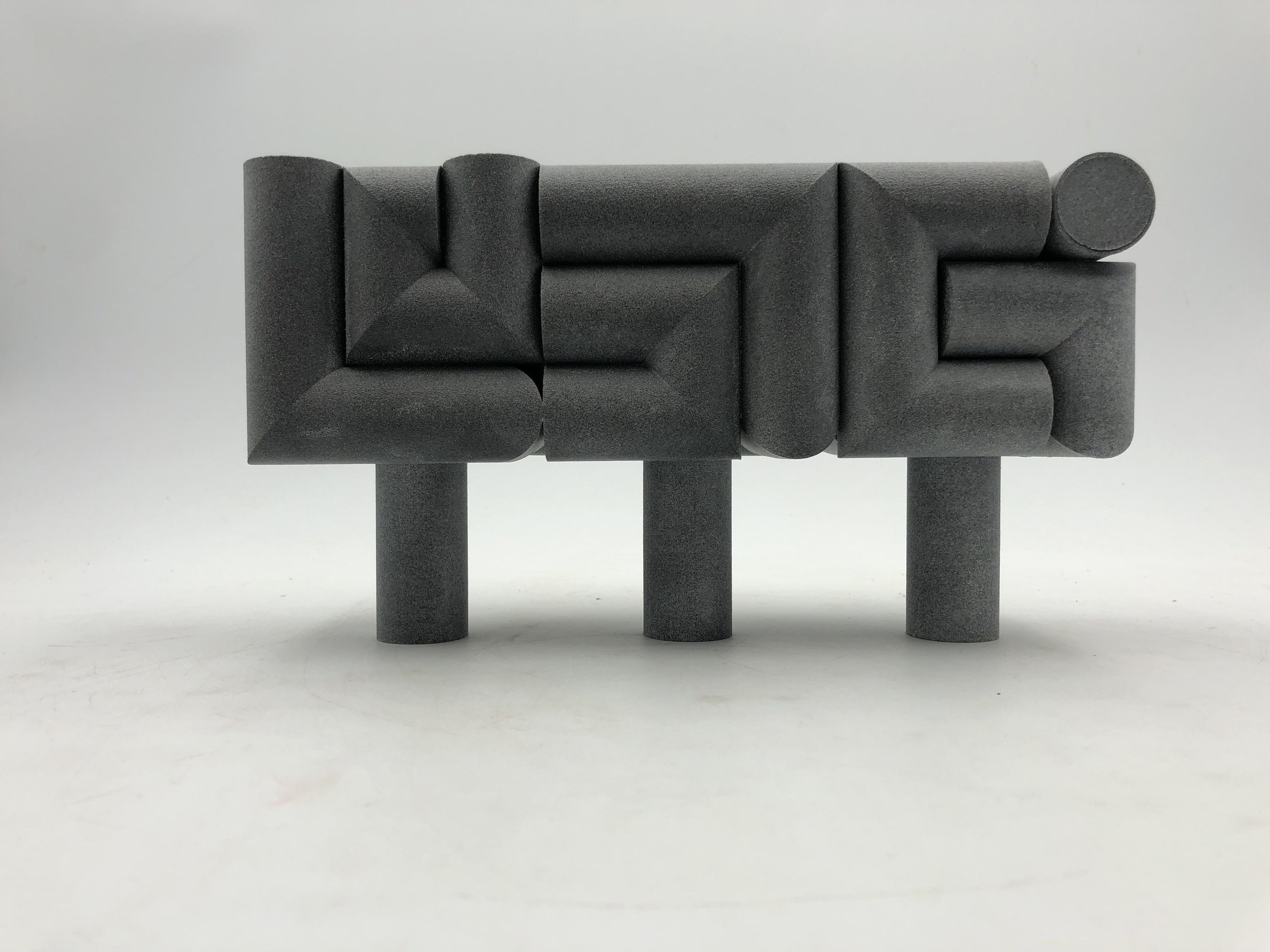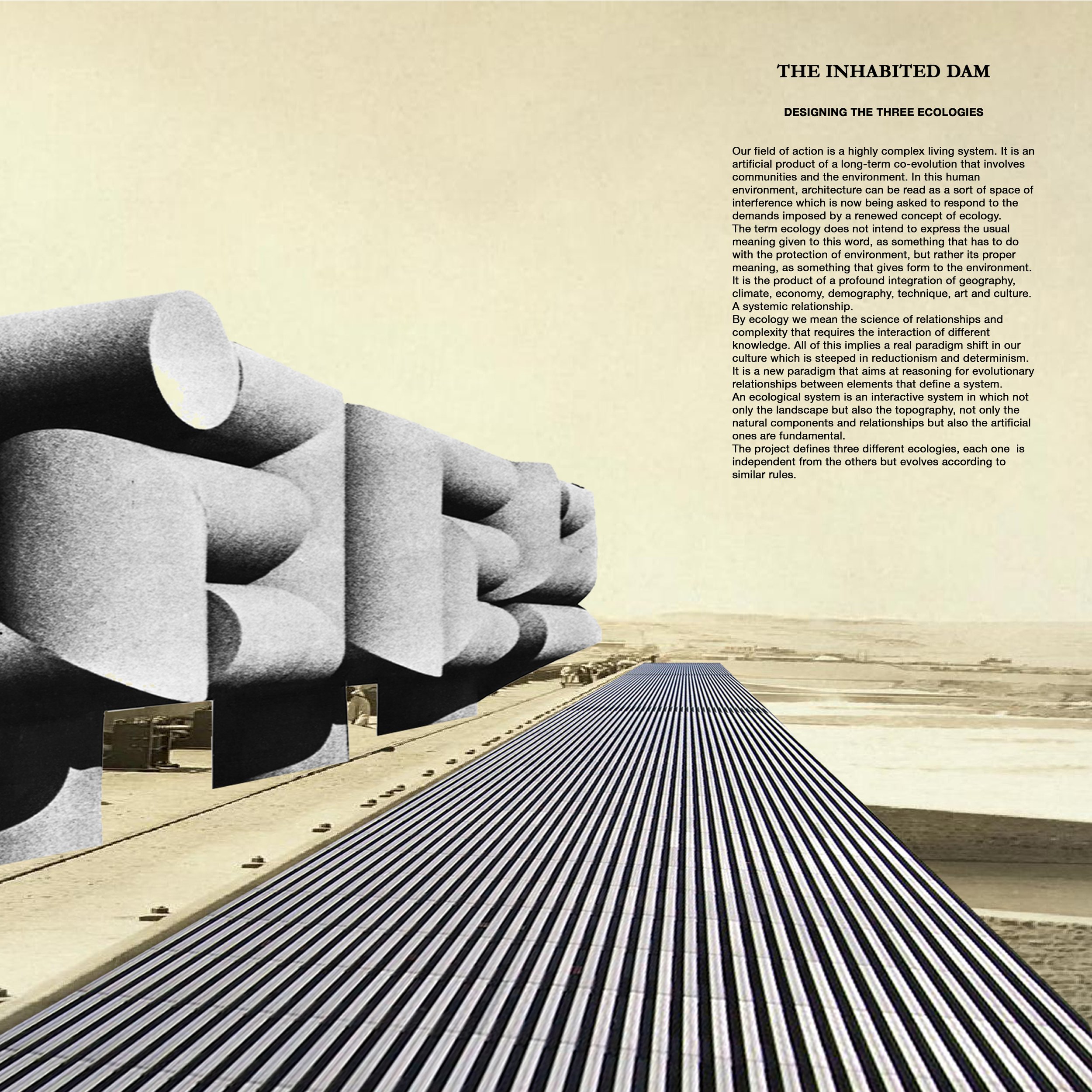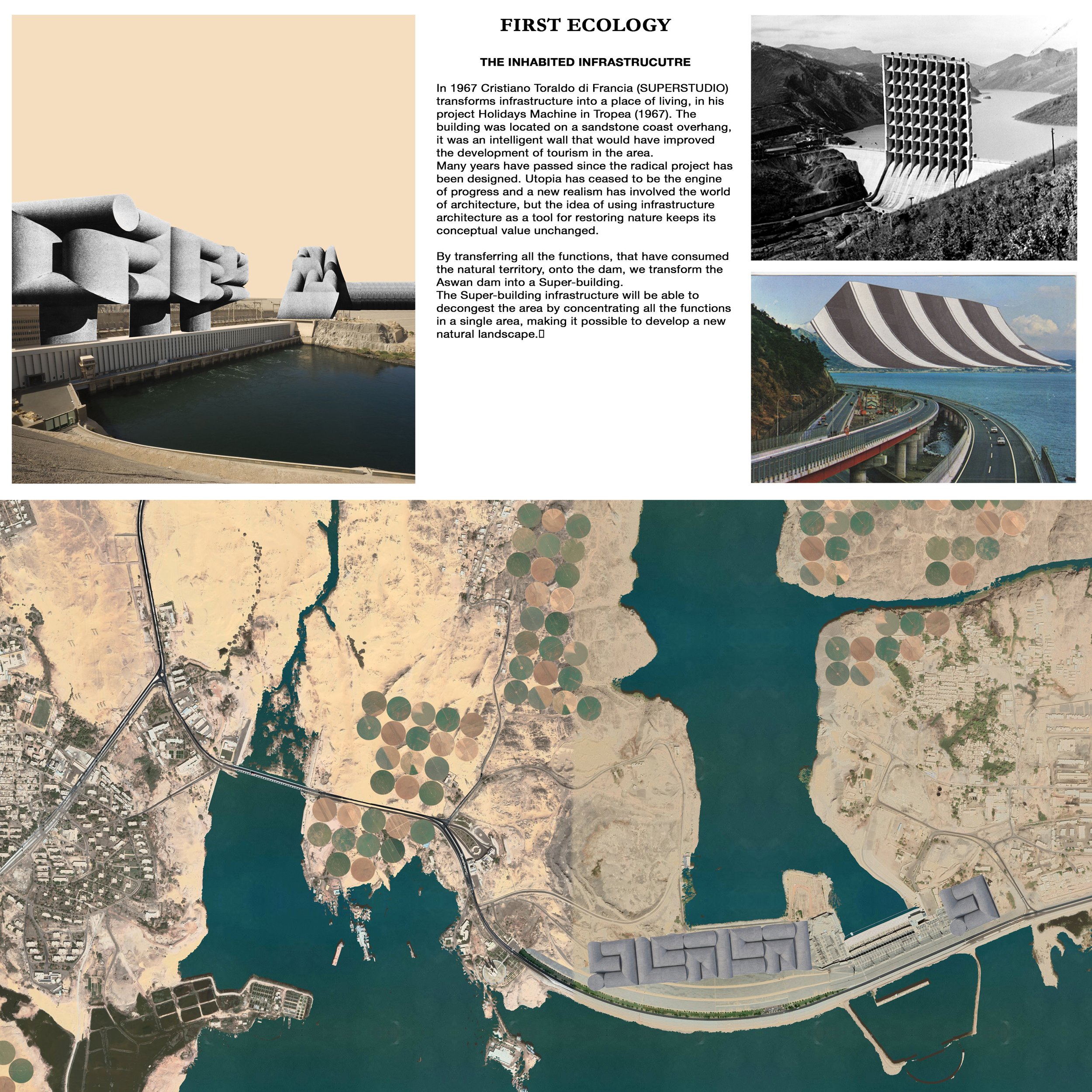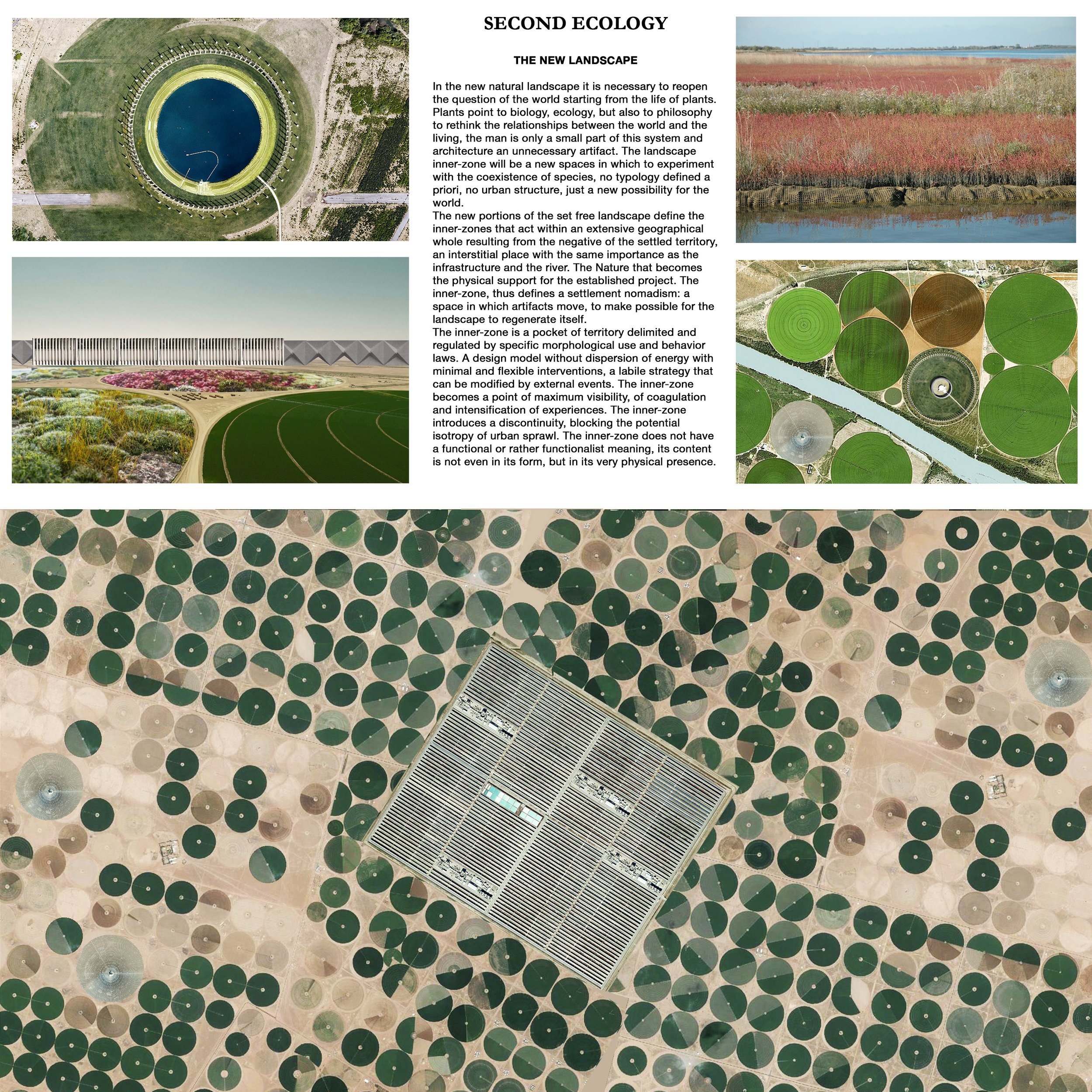Team leaders research group
Prof.Luca Galofaro (Università di Camerino)
Prof. Stefania Manna (Università dell’Aquila)
Student Rok Kuzman University of Ljubljana
Inclusioni in un altro mondo
Ad Aswan l’infrastruttura (High Dam) ha creato una radicale trasformazione del territorio contribuendo da una parte al controllo della geografia della regione, con i relativi benefici sociali ed economici, ma dall’altra alla sua totale disgregazione da un punto di vista paesaggistico e insediativo. La nostra idea di progetto pur mantenendo invariati gli aspetti tecnici dell’infrastruttura è focalizzata a rigenerare la qualità ambientale del sistema ecologico piuttosto che proporre un disegno insediativo del territorio. E’ necessario infatti ripensare il modo di abitare questi territori stressati dall’antropizzazione e dallo sfruttamento delle risorse naturali. Lo scrittore Patrick Chamoiseau dice che il mondo che conosciamo fino ad oggi non è il solo. Esiste un secondo mondo. Vederlo è immaginarlo. Questo secondo mondo disfa il reale. Il secondo mondo non è un mondo urbano. Ma l’urbano lo ha colpito. L’ecologia considera sempre ed esclusivamente l’ambiente in termini di habitat come scrive Emanuele Coccia invece diventa di fondamentale importanza riconoscere che c’è dell’inabitabile, che lo spazio non potrà essere mai davvero definitivamente abitatato… e che sia oggi necessario, piuttosto che di stabilirvisi in modo definitivo, di mescolarsi al meglio con l’ambiente.
Il termine ecologia ribadisce Nicolas Bourriaud rimanda sempre allo spazio domestico (Oikos la casa), non spinge a considerare il mondo come un sistema condiviso, eppure il mondo non è una casa gestita da un controllo centrale, ma uno spazio da condividere con le altre specie. Per ecologia intendiamo la scienza delle relazioni e della complessità che richiede l'interazione di diversi saperi. Tutto ciò implica un vero e proprio cambio di paradigma nella nostra cultura che è immersa nel riduzionismo e nel determinismo. È un cambio di paradigma che punta al ragionamento per relazioni evolutive tra elementi che compongono un sistema.
Le parole: deserto, fiume, infrastruttura richiamano ad immaginari diversi. Tutti questi immaginari possono essere visti come fatti concreti che si confrontano tra di loro nessuno deve prevalere sull’altro la loro deve essare una relazione simbiotica. Il confronto tra questi sistemi può diventare un occasione per ripensare come vivere in questi luoghi che possono essere considerati come tre diverse ecologie: Il deserto, il fiume, l’infrastruttura.
Il critico Reyner Banham definisce il deserto come il luogo delle possibilità a space for fulfilling the potential of modernity, an utopia place for new beginnings : It is a space absolutely anything becomes thinkable, and May consequentia happen. Il fiume invece rappresenta da diversi punti di vista, la vita, l’energia, l’economia, la possibilità di sviluppo ma anche un dispositivo che ha trasformato il paesaggio in un oggetto di consumo. Il Fiume e il deserto, la natura e l’anti-natura sono due opposti che divengono significanti quando vengono tenuti assieme dall’infrastruttura. L’infrastruttura rappresenta quell'insieme di opere pubbliche, cui si dà anche il nome di capitale sociale, che costituiscono la base dello sviluppo economico-sociale di un paese e, per analogia, anche quelle attività che si traducono in formazione di capitale personale. In questo caso specifico l’infrastruttura da una parte sostiene l’economia dall’altra non è capace di generare la diffusione delle funzioni urbane sul territorio con la formazione di una rete di strutture insediative gerarchicamente ordinate alla scala dell’uomo.
E’ necessario imparare a servirsi di queste forme geografiche, ecologie molto diverse tra loro, imparare a guardarle per poterne assecondare le trasformazioni, significa innanzitutto imparare ad abitare le diverse ecologie e farle proprie, senza consumare le risorse naturali ed ambientali. L’infrastruttura deve essere reinventata come elemento isolante dell’universo che come scrive Georges Bataille: si manifesta sempre come una particella che può entrare nella composizione di un insieme che la trascende. Per questo preciso motivo le nostre 3 ecologie: il deserto, il fiume e l’infrastruttura non devono instaurare tra di loro un rapporto di interdipendenza ma devono mantenere una propria autonomia per mescolarsi tra di loro in modo non pianificato e controllato.
Il nostro progetto di concentra sull’infrastruttura ma definisce i criteri di sviluppo delle tre ecologie è necessario quindi ricorrere a quella che Nicolas Bourriaud chiama estetica inclusiva dove forme e materie, così come l’essere umano e il suo ambiente formano una sorta di cooperativa. Per Aby Warburg, ogni atto artistico cerca di costruire ciò che lui chiama uno spazio mentale, un luogo di pensiero. Si tratta di stabilire una connessione tra la forza della Natura e l’Uomo, ovvero il simbolo, l’elemento che collega, l’io magico che stabilisce dei legami concreti delegando un mediatore. La Natura deve essere il luogo da abitare anche solo in modo temporaneo. Non esiste quindi un disegno del territorio ma un chiaro intento operativo, che attraverso delle regole, dei programmi e una volontà politica creerà le condizioni di uno sviluppo alternativo della regione.
INCLUSIONS in ANOTHER WORLD
In Aswan, the infrastructure (High Dam) has created a radical transformation of the territory, contributing to one hand to controlling the geography of the region, with the related social and economic benefits, but on the other hand to the destruction of the landscape and the settlements. While keeping the technical aspects of the infrastructure unchanged, our project idea is focused on regenerating the environmental quality of the ecological system rather than proposing a settlement design for the territory.
In fact, it is necessary to rethink the way of inhabiting these territories stressed by anthropization and the exploitation of natural resources. Writer Patrick Chamoiseau says the world we know to this day is not the only one. There is a second world. To see it means to imagine it. This second world undoes reality. The second world is not an urban world. But the urban hit him. Ecology always and exclusively considers the environment in terms of habitat, Emanuele Coccia writes that it becomes fundamental to recognize that there is something uninhabitable, the space can never really be definitively inhabited… and that it is necessary today, rather than to settle there definitively, to blend it with the environment.
Nicolas Bourriaud declare that the term ecology always refers to the domestic space (Oikos the house), it does not push us to consider the world as a shared system, yet the world is not a house managed by a central control, but a space to be shared with other species. By ecology we mean the science of relationships and complexity that requires the interaction of different knowledges. All of this implies a real paradigm shift in our culture which is steeped in reductionism and determinism. It is a paradigm shift that aims at reasoning for evolutionary relationships between elements that define a system. The words: desert, river, infrastructure recall different imaginaries. All these imaginaries can be seen as concrete facts that compare each other, none must prevail over the other their must be a symbiotic relationship. The comparison between these systems is an opportunity to rethink how to live in these places. Places that can be considered as three different ecologies: the desert, the river, the infrastructure. The critic Reyner Banham defines the desert as the place of possibilities a space for fulfilling the potential of modernity, an utopia place for new beginnings : It is a space absolutely anything becomes thinkable, and May consequentia happen.
The river instead represents from different points of view, life, energy, the economy, the possibility of development but also a device that has transformed the landscape into an object of consumption. The River and the desert, nature and anti-nature are two opposites that become significant when they are held together by the infrastructure. The infrastructure represents a set of public works, we can name it as social capital, which form the basis of the economic and social development of a country and, by analogy, also those activities which translate into the formation of personal capital. In this specific case the infrastructure on the one hand supports the economy on the other it is not capable of generating the diffusion of urban functions on the territory with the formation of a network of settlement structures hierarchically ordered by a human scale.
It is necessary to learn how to use these geographical forms, ecologies that are very different one from each other, learning to look at them in order to be able to accommodate their transformations. We need to learn how to inhabit the different ecologies and understand them, without consuming natural and environmental resources. The infrastructure must be reinvented as an element of the universe which, as Georges Bataille writes: always manifests itself as a part of a whole that transcends it. For this precise reason our 3 ecologies: the desert, the river and the infrastructure must not establish a relationship of interdependence but they must maintain their own autonomy to mix in an unplanned and uncontrolled way. Our project focuses on the infrastructure but defines the development criteria of the three ecologies to resort to what Nicolas Bourriaud calls inclusive aesthetics where forms and materials, as well as the human being and his environment create a sort of cooperative. For Aby Warburg, every artistic act seeks to construct what he calls a mental space, a place of thought. It is about establishing a connection between the force of Nature and Man, or rather the symbol, the element that connects, the magical ego that establishes concrete links by delegating a mediator. Nature must be the place to inhabit, even if only temporarily. There is therefore no design of the territory but a clear operational intent, which through rules, programs and a political will will create the conditions for an alternative development of the region.
PROGETTARE LE TRE ECOLOGIE
Il territorio, sistema vivente di elevata complessità, prodotto–artificiale, e non naturale della co-evoluzione di lungo periodo che coinvolge comunità insediate e ambiente, è il nostro campo d’azione. In esso, ‘spazio umano’ per eccellenza, l’architettura può essere letta come una sorta di spazio d’interferenza cui si chiede ora di rispondere alle istanze imposte da un rinnovato concetto di ecologia. Il termine ecologia non intende esprimere il senso consueto che si da a questa parola, come qualcosa che ha a che fare con la protezione dell'ambiente, ma piuttosto il suo senso proprio, come qualcosa che conforma l'ambiente. È il prodotto di una profonda integrazione di geografia, clima, economia, demografia, tecnica, arte e cultura. Relazione sistemiche.
Per ecologia intendiamo la scienza delle relazioni e della complessità che richiede l'interazione di diversi saperi. Tutto ciò implica un vero e proprio cambio di paradigma nella nostra cultura che è immersa nel riduzionismo e nel determinismo. È un cambio di paradigma che punta al ragionamento per relazioni evolutive tra elementi che compongono un sistema. Un sistema ecologico è infatti un sistema interattivo in cui è fondamentale non solo il paesaggio ma anche la topografia, non solo le componenti e le relazioni naturali ma anche quelle artificiali. Il progetto definisce tre diverse ecologie, ognuna delle quali è indipendente dall’altra ma evolve secondo regole simili.
DESIGNING THE THREE ECOLOGIES
The territory a highly complex living system, the artificial product of the long-term co-evolution that involve communities and the environment, it is our field of action. In this human environment, architecture can be read as a sort of space of interference which is now being asked to respond to the demands imposed by a renewed concept of ecology. The term ecology does not intend to express the usual meaning given to this word, as something that has to do with the protection of the environment, but rather its proper meaning, as something that give forms to the environment. It is the product of a profound integration of geography, climate, economy, demography, technique, art and culture. Systemic relationship.
By ecology we mean the science of relationships and complexity that requires the interaction of different knowledge. All of this implies a real paradigm shift in our culture which is steeped in reductionism and determinism. It is a new paradigm that aims at reasoning for evolutionary relationships between elements that define a system. An ecological system is an interactive system in which not only the landscape but also the topography, not only the natural components and relationships but also the artificial ones are fundamental.
The project defines three different ecologies, each one is independent from the others but evolves according to similar rules.
FIRST ECOLOGY _the inhabited infrastructure
Nel 1967 Cristiano Toraldo di Francia (SUPERSTUDIO) con il progetto Macchina per vacanze a Tropea (1967), trasforma l’Infrastruttura in un luogo da abitare. La diga definiva un progetto di restauro della natura. L’edificio Diga era localizzato su uno strapiombo costiero di arenaria, un muro intelligente che avrebbe contribuito allo sviluppo del Turismo dell’area. Molti anni sono passati da quel progetto radicale. L’utopia ha smesso di essere il motore del progresso e un nuovo realismo ha invaso il mondo dell’architettura, ma l’idea di utilizzare l’architettura dell’infrastruttura come strumento di restauro del naturale mantiene inalterato il suo valore concettuale. Costruire un nuovo edificio sulla nuova diga di Aswuan trasferendo in questo super edificio tutte le funzioni che dal periodo della sua costruzione hanno consumato il territorio naturale.
La super infrastruttura sarà capace di decongestionare il territorio concentrando tutte le funzioni in un unico edificio rendendo possibile la definizione di un nuovo paesaggio naturale. In 1967 Cristiano Toraldo di Francia (SUPERSTUDIO) with the project Holidays Machine in Tropea (1967), transforms the infrastructure into a place to live. The dam is used to restore the nature. The building was located on a coast sandstone overhang, was an intelligent wall that would have improved the development of tourism in the area.
Many years have passed since that radical project was designed. Utopia has ceased to be the engine of progress and a new realism has involved the world of architecture, but the idea of using infrastructure architecture as a tool for restoring nature keeps its conceptual value unchanged. Trasforming the Aswuan dam in a superbuiding by transferring inside all the functions that have consumed the natural territory since the period of its construction. The super building infrastructure will be able to decongest the area by concentrating all the functions in a single area, making possible the development of a new natural landscape.
SECOND ECOLOGY_ THE NEW LANDSCAPE
Nel nuovo paesaggio naturale è necessario riaprire la questione del mondo a partire dalla vita delle piante. Le piante impongono alla biologia, all’ecologia, ma anche alla filosofia, di ripensare di nuovo le relazioni che intercorrono tra mondo e vivente, l’uomo è solo una parte di questo sistema, l’architettura un artefatto non necessario. Il paesaggio sarà una nuova zona in cui sperimentale la convivenza tra specie, nessuna tipologia definita a priori nessuna struttura urbana, solo una nuovo possibilità per il mondo. Le nuove porzioni di paesaggio definiscono le interzone che agiscono all’interno di un esteso insieme geografico risultante dal negativo del territorio insediato, un luogo interstiziale di grande scala la stessa dimensione dell’infrastruttura e del fiume. Un infrastruttura naturale che diviene il supporto fisico al progetto insediato. L’interzona così concepita definisce un nomadismo insediativo: uno spazio in cui si muovono gli artefatti per lasciare al paesaggio la possibilità di rigenerarsi secondo uno schema simile alla rotazione colturale dei terreni agricoli. L’interzona è una sacca di territorio delimitata e regolata da specifiche leggi morfologiche, di uso e comportamento. Un modello progettuale senza dispersione di energie con interventi minimi e flessibili una strategia labile e modificabile dagli eventi esterni. L’interzona diventa un punto di massima visibilità , di coagulo e di intensificazione delle esperienze. L’interzona introduce una discontinuità, bloccando la potenziale isotropia dell’espansione urbana. L’interzona non ha un significato di tipo funzionale o meglio funzionalista il suo contenuto non è nemmeno nella forma, ma nella sua stessa presenza fisica.
In the new natural landscape it is necessary to reopen the question of the world starting from the life of plants. Plants impose to biology, ecology, but also to philosophy to rethink the relationships between the world and the living, man is only a small part of this system and architecture an unnecessary artefact. The landscape interzone will be a new spaces in which to experiment with the coexistence of species, no typology defined a priori, no urban structure, just a new possibility for the world. The new portions of the set free landscape define the interzones that act within an extensive geographical whole resulting from the negative of the settled territory, an interstitial place with the same importance as the infrastructure and the river. The Nature that becomes the physical support for the established project. The interzone thus conceived defines a settlement nomadism: a space in which artifacts move to leave the landscape the possibility of regenerating itself. The interzone is a pocket of territory delimited and regulated by specific morphological, use and behavior laws. A design model without dispersion of energy with minimal and flexible interventions, a labile strategy that can be modified by external events. The interzone becomes a point of maximum visibility, of coagulation and intensification of experiences. The interzone introduces a discontinuity, blocking the potential isotropy of urban sprawl. The interzone does not have a functional or rather functionalist meaning, its content is not even in its form, but in its very physical presence.
THIRD ECOLOGY_ THE CULTURE ISLAND
L’arte è un energia rinnovabile che per lungo tempo ha avuto una posizione centrale nelle società umane e l’antropologia contemporanea ci supporta in questa convinzione: al di la della soddisfazione di un bisogno estetico, l’arte indica secondo quali principi si organizza lo spazio di una società, come vi si trasmettono i saperi e vi circolano i segni. E’ necessario utilizzare l’arte in un mondo dove predomina l’urgenza del progresso. Il progetto vuole definire e rafforzare l’idea delle isole della cultura dove il riposizionamento dei templi e delle strutture archeologiche e degli spazi per l’arte produce una rigenerazione che si fonda sulla cultura e la memoria dei luoghi. Su queste isole naturali ed artificiali prende vita un sistema antropizzato che dialoga attraverso l’arte con la natura. La cultura diventa così il nuovo motore di sviluppo dell’area.
Art is a renewable energy that has had a central position in human societies from long time and contemporary anthropology supports us in this conviction: beyond the satisfaction of an aesthetic need, art indicates according to which principles the space of a society, how knowledge is transmitted and signs circulate. It is necessary to use art in a world where the urgency of progress predominates. The project aims to define and strengthen the idea of islands of culture where the repositioning of temples and archaeological structures and spaces for art produces a regeneration based on the culture and memory of places. On these natural and artificial islands, an anthropized system comes to life that dialogues with nature through art. Following this attitude Culture, as dialogue between art and memory, becomes the new development engine of the area.








